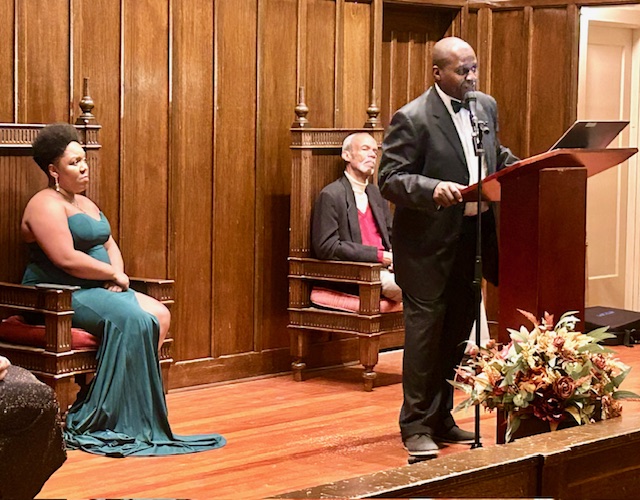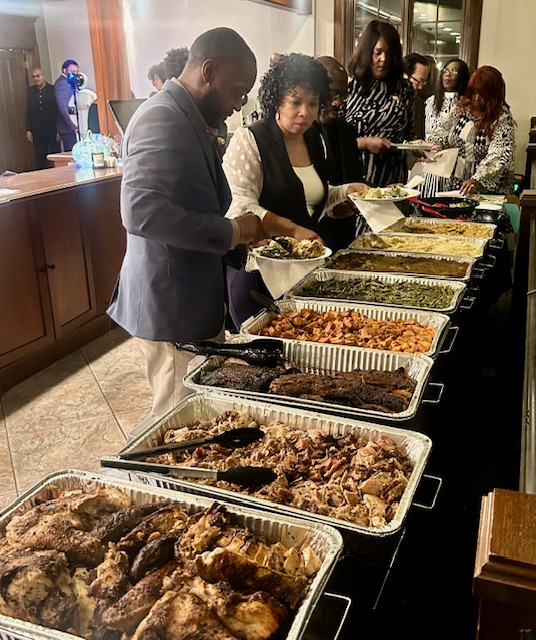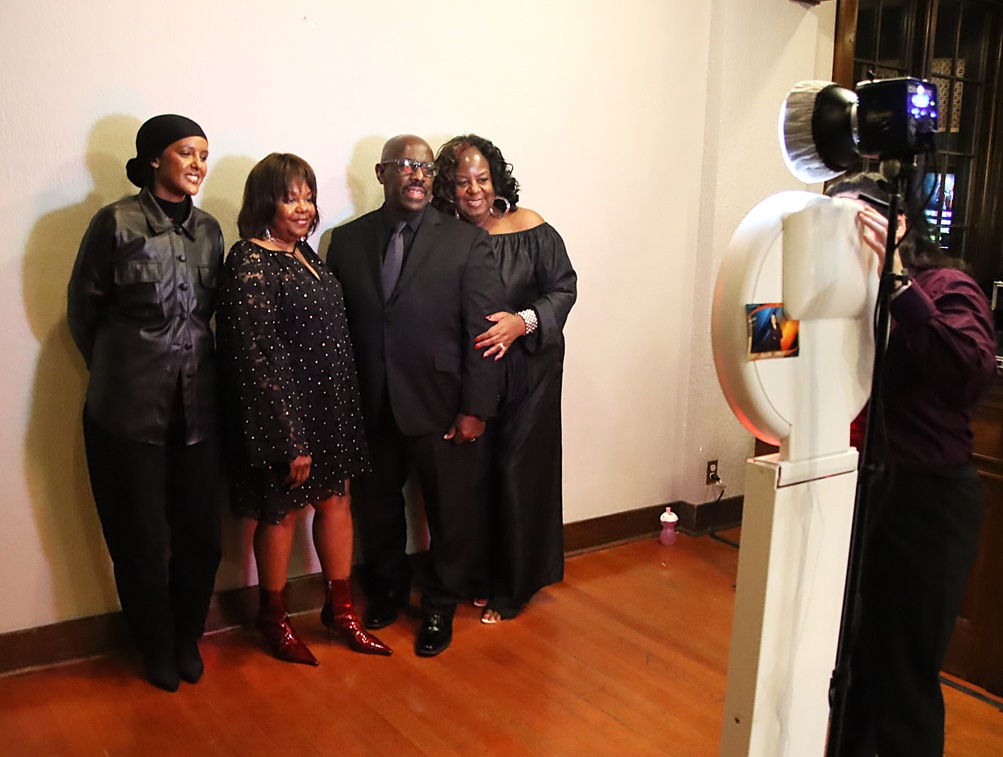
WSBLI’s Clyde Merriwether, Ashleigh McCurdy, Kateesha Atterberry, Roger Evans
(photo courtesy of Kateesha Atterberry, from Thursday’s event)
Story by Jason Grotelueschen
Photos by Jason Grotelueschen (unless otherwise noted)
Reporting for West Seattle Blog
The vibrant history and bright future of the Black community in the state of Washington were celebrated Thursday night at the Legacy of Learning: Building Futures Together fundraising event at the Washington State Black Legacy Institute (WSBLI) in West Seattle.
As we previewed last week, the dinner and social event was held in the group’s space at 2656 42nd SW in West Seattle’s Admiral District, which opened earlier this year with a mission of community engagement and sharing information about local Black history in compelling ways.
The group says it “doesn’t just preserve the past – we architect the future” through exhibitions, education, storytelling, and strategic partnerships to ensure that “Black stories in Washington are not only told, but celebrated and built upon.”
On Thursday night, the group shared their achievements and vision and rallied support for their ongoing and new projects.
Keynote speaker Dr. Keisha Scarlett, a longtime educator and school administrator with deep history in Seattle, gave rousing remarks later in the evening about the crucial mission of “protecting Black brilliance” and the importance of using imagination and hard work to tackle educational inequity and do amazing things for young people:

To open the evening’s program, WSBLI president/CEO Kateesha Atterberry shared updates about the group’s mission and activities, and implored guests to get involved and support their important work:

Atterberry is the founder of real-estate/development firm Urban Black, which partnered with WSBLI to purchase the city-landmarked building (built in 1924) where the event was held which the group calls home (it’s the former location of Christian Science church and the Sanctuary at Admiral).
As described by Atterberry, WSBLI is designed to be permanent cultural institution dedicated to documenting, preserving, teaching, and celebrating Black history and achievements across Washington State.
“This is your space, your building, your place,” Atterberry emphasized, “and it’s more than a museum,” owned, governed, and operated by the community it serves. It is designed as a place where children and youth see themselves reflected in exhibits, curriculum, and leadership, and where elders’ life work is honored. It’s intended to be forward-looking and also ties cultural preservation to economic empowerment, as part of the same history. Core programs and services include:
- Youth and family education programs.
- Pilot preservation and research access.
- Cultural exhibitions, lectures, and public storytelling.
- Entrepreneurship and wealth-building workshops.
- Business development and technical assistance.
- Leadership development and community organizing training.
Atterberry ran through a list of development projects and initiatives, including a new 113-unit project at 23rd and Cherry, which is a construction collaboration financed by the Amazon Housing Equity Fund. She also described a community facility partnership in collaboration with Fathers and Sons Together (FAST) on the FAST Resource & Outreach Center (aka FAST ROC).
Next on stage was Roger Evans, who serves as WSBLI’s curator, historian and vice president, talked about the strategies that the group employs as it relates to gathering, preserving and sharing stories of the Black community in Washington state:

Evans said his personal interest in fostering intergenerational links and connecting elders to youth began over a decade ago, and he showed two of his family videos that underscored the importance of this work. He also shared stories of families moving from places like Oklahoma to Washington State almost a century ago, buying land and starting business and establishing lasting roots in the area.
Evans added that the WSBLI building is designed “to empower us see ourselves in the future,” with advanced multimedia combined with photographs and portraits for viewing. The group’s activities include oral history collection and digitizing in elders’ homes, schools, libraries, theaters, and residences, and then creating and archiving content including 360-degree videos and VR-enabled experiences to preserve the subjects’ presence, body language, and voice. They also do image restoration using AI. To engage with the larger community, they do public exhibits and outreach and collaborations with schools, museums, and universities.
Evans says the institute plans to soon launch a website featuring 10,000 prepared digital items for public access on mobile devices, which will take the group’s engagement to the next level.
The group then invited Scarlett to the stage for her keynote speech, which focused on the current state of education and society, children’s challenges, and the role of wisdom and faith:

Scarlett emphasized the importance of creating an educational ecosystem that co-develops identity but that “survival isn’t enough” — we need to assert presence, dignity, and purpose, and a strong desire for every child to have the same ecosystem.
She focused on “Black brilliance” as a core topic, and said “education should reveal brilliance, not expose weakness.” She added that it’s important to reframe traditional thinking, because “achievement gaps are just imagination gaps” caused by institutions lacking imagination, courage, and commitment to see brilliance in its students. “Black children are not underperforming; the systems are.”
She acknowledged the challenges of the current political landscape, but recognized continuity with the past: “We have been here before.” Black-led institutions truly matter, and “we don’t wait for the storm to pass, we dance in the storm.”
Scarlett closed by encouraging attendees to remember that “joy is strategy,” “we are the ancestors of the future that we are building,” and that it’s up to us to “build a future where every child has what they need, every family is stable, every community is whole” and to “build ecosystems that protect identity, reveal gifts, and develop leaders who develop leaders.”
Guests on Thursday night enjoyed a Thanksgiving-inspired buffet meal, drinks and dessert:

And a photo booth:

Partner organizations Redeemed Wellness Center and Tiny Tots Development Center also had informational tables at the event.
After the event wrapped up in the main-level room, WSBLI’s Clyde Merriwether took us on a quick tour of the lower level of the building, which houses the institute’s exhibits and displays, and serves as a centerpiece for showcasing the rich history that the group works hard to preserve.
 (Photo courtesy Admiral Neighborhood Association)
(Photo courtesy Admiral Neighborhood Association)
We also caught up with Evans at Atterberry after the event. Evans said the group has hosted about 10 events this year, with plans to do more in the future. He said the focus of tonight’s event was to “talk about what we do,” and of course to raise money, but he emphasized that beyond money, the group also needs more volunteers in order to really bring its mission to life. Atterberry said that in the time since the group opened its doors in the Admiral District, neighbors have been “amazing and welcoming” and her group wants to return the favor by “being a real pillar to the community.”
There were also several mentions Thursday night of the Seattle Griot Project, which is a local effort and parent organization that formed the foundation for WSBLI as it relates to documenting Black history in the area.
For more information and to get involved, you can contact the organization via e-mail at wsblacklegacyinstitute@gmail.com.

| 4 COMMENTS